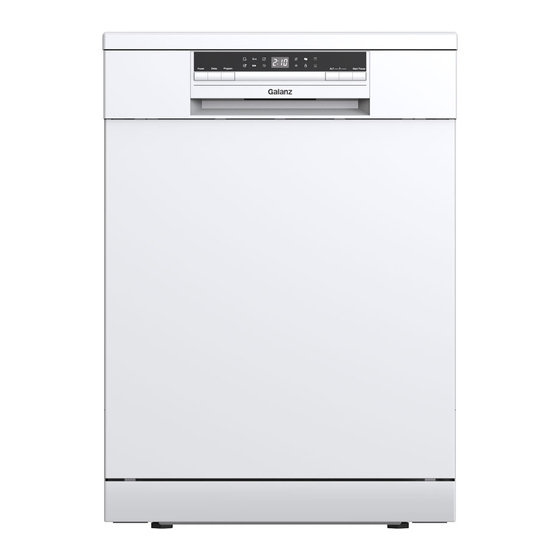Galanz DWUK003W Manuel d'instruction de l'utilisateur - Page 5
Parcourez en ligne ou téléchargez le pdf Manuel d'instruction de l'utilisateur pour {nom_de_la_catégorie} Galanz DWUK003W. Galanz DWUK003W 14 pages.

C. Place the end of the funnel (supplied) into the hole and introduce approximately 2kg of salt. It is
normal for a small amount of water to come out of the salt container.
D. Carefully screw the cap back on.
E. Usually, the salt warning light will turn off in 2-6 days after the salt container is filled with salt.
1. The salt container must be refilled when the salt warning light in the control panel comes
NOTE:
on. Though the salt container is full, the indicator light may not black out before the salt
fully dissolves. If there is no salt warning light in the control panel (for some models),
you can judge when to load the salt into the softener by the cycles that the dishwasher
had run.
2. If salt spills,run a soak programme to rinse the dishwasher out.
C. Filling the Rinse Aid Dispenser
Function of Rinse Aid
Rinse aid is automatically added during the last rinse, ensuring thorough rinsing, spot and streak
free drying.
Attention!
Only use a branded rinse aid for the dishwasher. Never fill the rinse aid dispenser with any other
substances (e.g. dishwasher cleaning agent, liquid detergent). as this could cause damage to
the appliance.
When to Refill the Rinse Aid Dispenser
If there is no rinse-aid warning light on the control panel, you can judge the amount of rinse-aid by
the colour of the optical level indicator "D" located next to the cap. When the rinse-aid container is
full, the whole indicator will be dark. As the rinse aid diminishes, the size of the dark dot decreases.
You should never let the rinse aid get below 1 / 4 full.
As the rinse aid diminishes, the size of the black dot
on the rinse aid level indicator changes, as illustrated below.
Full
3 / 4 full
1 / 2 full
1 / 4 full - Should refill to eliminate spotting
Empty
RINSE AID DISPENSER
1
2
6
D (Rinse-Aid indicator)
4
3
2
5
1
6
MAX
3
1
To open the dispenser, turn the cap to the "open" (left) arrow and lift it out.
Pour the rinse aid into the dispenser, be careful not to overfill.
2
Replace the cap by inserting and aligning it with the "open" arrow and turning it to the
3
"closed"(right) arrow
The rinse aid is released during the final rinse to prevent water from forming droplets on your dishes
that can leave spots and streaks. It also improves drying by allowing water to drain off the dishes.
Your dishwashers are designed to use liquid rinse aids. The rinse aid dispenser is located inside the
door next to the detergent dispenser.
To fill the dispenser, open the cap and pour the rinse aid into the dispenser until the level indicator
turns completely black. The volume of the rinse aid container is about 140ml.
Be careful not to overfill the dispenser, as this could cause excessive foam. Wipe away any spills
with a damp cloth. Don't forget to replace the cap before you close the dishwasher door.
Attention!
Clean up any rinse aid spilt during filling with an absorbent cloth to avoid excess foaming during the
next wash.
Adjusting the Rinse Aid Dispenser
The rinse aid dispenser has four or six settings . Always
Start with the dispenser set on "4" If spots and poor drying are
problems, increase the amount of rinse aid dispensed by removing
the dispenser lid and rotating the dial to "5". If the dishes still are
not drying properly or are spotted, adjust the dial to the next higher
number until your dishes are spot-free. The dose is factory set in
position 5.
NOTE: Increase the dose if there are drops of water or lime spots on the dishes after washing.
Reduce it if there are sticky whitish streaks on the dishes or a bluish film on glassware or knife
blades.
D. Function of Detergent
Detergents with its chemical ingredients are necessary to remove dirt, dissolve dirt and transport it out
of the dishwasher. The majority of commercial
Concentrated Detergent
Based on their chemical composition, detergents can be spilt in two basic types:
■conventional, alkaline detergents with caustic components
■Low alkaline concentrated detergents with natural enzymes
The use of "Eco" washing programme in conjunction with concentrated detergents reduces pollution
and is good for your dishes; these washing programmes are specially matched to the dirt-dissolving
properties of the enzymes of the concentrated detergent. For this reason"Eco" washing programme
in which concentrated detergents are used can achieve the same results that can otherwise only be
achieved using"intensive" programme.
Detergent Tablets
Detergent tablets of different brands dissolve at different speeds. For this reason some detergent
4
3
2
5
1
6
MAX
Adjust lever
(Rinse)
quality detergents are suitable for this purpose.
7
9
